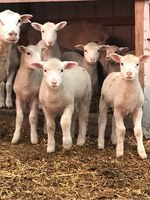Sheep Producers Need to Keep Marketing Options Open
(Click the image below to view a high-resolution image that can be downloaded)
Sheep producers need to keep their marketing options open during the COVID-19 outbreak, says Travis Hoffman, North Dakota State University Extension sheep specialist.
“We are undoubtedly in a different time than expected for livestock producers in today’s COVID-19 situation,” he says. “Breeding decisions were made, we put in the effort to get calves, piglets, lambs and/or kids on the ground and growing well. However, we are facing an unprecedented challenge for harvesting the fruition of our efforts for livestock production.”
The harvest slaughter lamb volume was down 38% for the week ending April 17 and is down 12% for 2020.
“Our current lambs on feed inventory are up 8% over last year, and we are on a full path to industry challenges of too much supply as we come through the summer months of sheep and lamb production,” Hoffman says.
The lamb industry is highly dependent on the currently non-existent restaurant trade. Thus, retail is sheep producers’ primary market. During the weeks of March 15 and March 22, lamb purchases in the retail sector had growth of 55% over yearly expectations, but this has not been sustained as people load their refrigerators and freezers.
“There is greater demand than ever from the consuming sector to know the producer, and I hope that we can mitigate current challenges via providing a direct market for our consumers of high-quality protein for the family meals,” Hoffman says. “Local food is not new, but the chances to learn more about production practices and building relationships with producers may be at a heightened priority for our consumers.”
One option is for a producer to sell a live animal (prior to slaughter) directly to a consumer. The animal then goes through a custom-exempt plant. That plant is exempt from continuous inspection and only can slaughter and process livestock for the exclusive use of the owners, the owners’ family and nonpaying guests. The packages of meat must be labeled “not for sale.”
However, if an individual wants to merchandise meat products, a limiting factor is the need for a state or U.S. Department of Agriculture (USDA) inspection of the processing plant. Meat originating from state-inspected facilities can be sold only within the state’s boundaries, and USDA-inspected meat can be sold in-state or via interstate commerce.
The North Dakota Department of Agriculture has a website at https://tinyurl.com/NDMeatProcessors with information for producers who want to harvest their animals and/or merchandise the meat. For information in Minnesota, go to the Minnesota Department of Agriculture site at https://www.mda.state.mn.us/minnesota-state-equal-plants.
“Working with meat processors can provide proactive options with depressed live animal markets for producers to develop alternatives for marketing throughout the spring and summer with challenges that we have never faced,” Hoffman says. “Keep your options open.”
NDSU Agriculture Communication - April 28, 2020
| Source: | Travis Hoffman, 701-231-2222, travis.w.hoffman@ndsu.edu |
|---|---|
| Editor: | Ellen Crawford, 701-231-5391, ellen.crawford@ndsu.edu |


